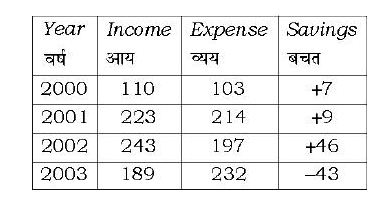Out of 32 persons, 30 invest in National Savings Certificates and 17 invest in shares. What is the number of persons who invest in both?
13
15
17
19
The correct Answer is:B
To solve the problem, we will use the principle of inclusion-exclusion. Let's denote:
- N: the number of persons who invest in National Savings Certificates.
- S: the number of persons who invest in shares.
- B: the number of persons who invest in both National Savings Certificates and shares.
From the problem, we have the following information:
- Total number of persons = 32
- Number of persons who invest in National Savings Certificates, N=30
- Number of persons who invest in shares, S=17
We need to find the number of persons who invest in both, B.
Using the principle of inclusion-exclusion, we can express the total number of persons as:
N+S−B=Total number of persons
Substituting the known values into the equation:
30+17−B=32
Now, we can simplify this equation:
47−B=32
Next, we will isolate B:
B=47−32
Calculating the right-hand side gives:
B=15
Thus, the number of persons who invest in both National Savings Certificates and shares is 15.
Final Answer:
The number of persons who invest in both is 15.
- S: the number of persons who invest in shares.
- B: the number of persons who invest in both National Savings Certificates and shares.
- Number of persons who invest in National Savings Certificates, N=30
- Number of persons who invest in shares, S=17
The number of persons who invest in both is 15.
Topper's Solved these Questions
Similar Questions
Mr Trivedi invested 4% of ₹1,00,000 in shares. What amount did he invest in shares?
View SolutionA person buys every year National Saving Certificates of value exceeding that last year's purchase by Rs. 500. After ten years he finds that the total value of the national saving certificates purchased by him is Rs. 27,500. Find the value of the certificates purchased by him in the first year.
View Solution
Knowledge Check
Shalmali wanto to invest Rs. 50,000 in saving certificates and PPF. She went to invest at least Rs. 15,000 in saving certificates and at least Rs. 20,000 in PPF. The rate of interest on saving certificates is 8% p.a. and on PPF is 9% p.a. Formulate the LPP for maximun yearly income.
AMaximize z=0.08x+0.09y subject to x+y≤50000,x≤15000,y≥20000,x≥0,y≥0BMaximize z=0.08x+0.09y subject to x+y≤50000,x≥15000,y≤20000,x≥0,y≥0CMaximize z=0.08x+0.09y subject to x+y≤50000,x≥15000,y≥20000,x≥0,y≥0DMaximize z=0.08x+0.09y subject to x+y≤50000,x≤15000,y≤20000,x≥0,y≥0profit shared by two persons A and B at the end of a year are in the ratio 3:2. If A's investment is twice that of B's, then what is the ratio of the periods of investments of A and B?
A2:3B3:2C3:8D8:3profit shared by two persons A and B at the end of a year are in the ratio 3:2. If A's investment is twice that of B's, then what is the ratio of the periods of investments of A and B?
A2:3B3:2C3:8D8:3
Sachin invested Rs. 5000 for the 1st year, Rs. 7000 for the 2nd year, Rs. 9000 in the 3rd year in National Savings Certificate scheme. How much amount did he invest in 12 yearsgt
View SolutionIf plannned savings are greater than planned investments, what will be its effect on investment?
View SolutionA retired person has Rs 70,000 to invest and two types of bonds are available in the in the market investment. First type of bond yields an annual income of 8% on the amount investment invested and second type of bond yields 10% per annum. As per norms, he has to invest minimum in the first type and not more than 30,000 in the second type. How should investment, so as to get maximum returns, after one year of investment?
View SolutionA person earns 15% on an investment but loses 10% on another investment. If the ratio of the two investments be 3 : 5, what is the gain or loss on the two investments taken together? 614%loss b. 1318%ga∈ c. 1318%loss d. none of these
View SolutionThe table shows income and expenditure of a person for 3 years

In the given table, if a person invested his savings every year at 8% simple interest, how much interest will he earn at the end of 2003
View Solution
